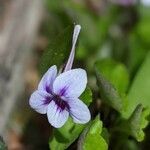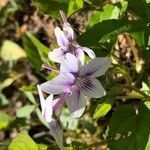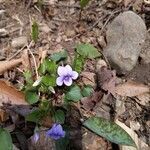Plants perennial, caulescent, not stoloniferous, 5–20 cm. Stems 1–7, ascending to erect (often declining during anthesis), glabrous, on caudex from fleshy rhizome. Leaves basal and cauline; basal: 1–5; stipules lanceolate, margins laciniate, apex acute; petiole 1–9.6 cm, glabrous; blade sometimes purple-spotted abaxially and/or adaxially, reniform to ovate, 1–4.5 × 1–4 cm, base broadly cordate to cordate, margins crenate to serrate, mostly eciliate, apex obtuse to acute, surfaces usually pubescent, mostly adaxially toward base, sometimes glabrous; cauline similar to basal except: petiole 0.4–4 cm; distal cauline blades ovate to deltate, 1–4.5 × 1–4 cm, base cordate, apex acuminate to acute. Peduncles 5–9 cm, usually glabrous. Flowers: sepals lanceolate, margins eciliate, auricles 1–2 mm; petals pale lavender-violet on both surfaces, all white basally, lower 3 purple-black-veined, all beardless, lowest 8–20 mm, spur white, purple, or lavender-tinged, elongated, 10–20 mm; style head beardless; cleistogamous flowers axillary. Capsules ellipsoid, 4–6 mm, glabrous. Seeds beige to bronze, 1.3–2 mm. 2n = 20.
More
Essentially glabrous, the stems erect or spreading from a branched, oblique, short rhizome, 5–12 cm at anthesis, later 15–25 cm, lvs ovate, often broadly so, 2–4 cm, cordate at base, all but the lowermost acute; stipules lanceolate, fimbriate-toothed above the middle; fls elevated above the lvs; pet light violet, with darker veins forming a pronounced eye, all beardless; spur 7–12 mm, slender, slightly upcurved at the tip; style slender, the tip straight, smooth; fr stoutly ellipsoid, 5–6 mm; seeds light yellow-brown; 2n=20. Shady slopes and woodlands, usually in deep humus; Me. and Que. to Mich. and e. Wis., s. to Ga. and Ala. Apr.–June. Hybridizes with nos. 22 [Viola striata Aiton] and 24 [Viola conspersa Rchb.].



